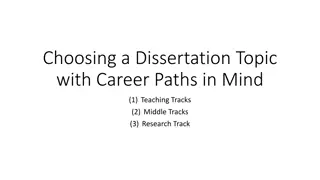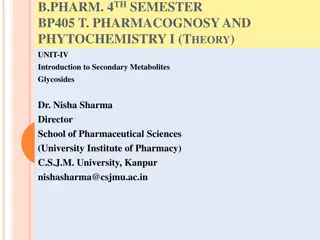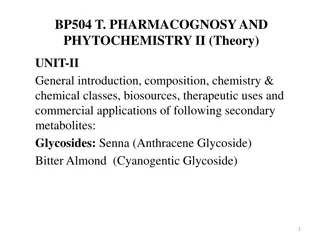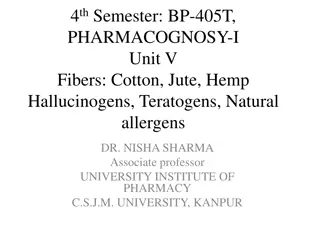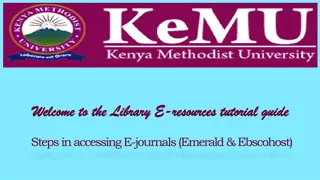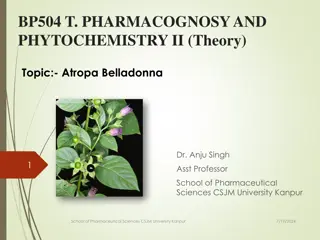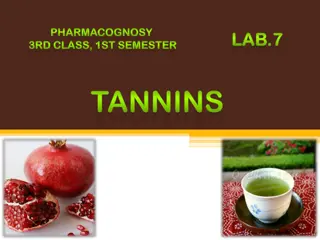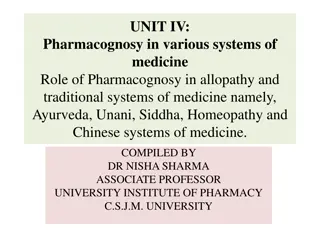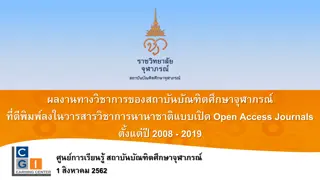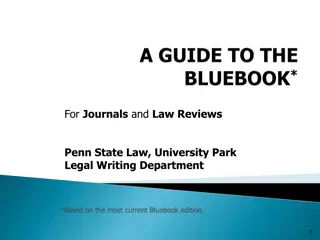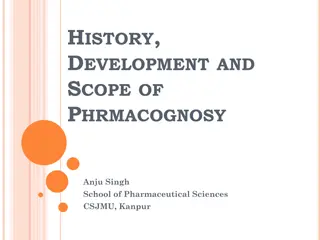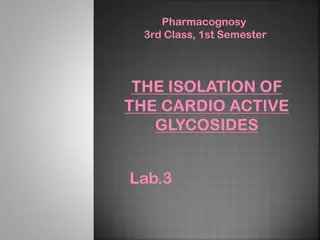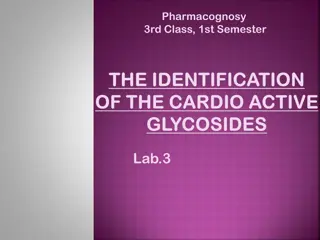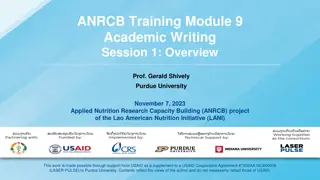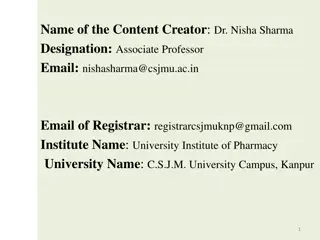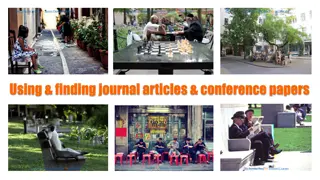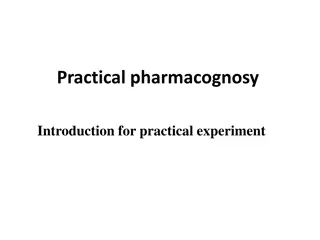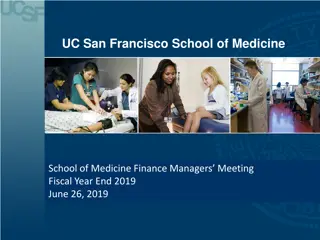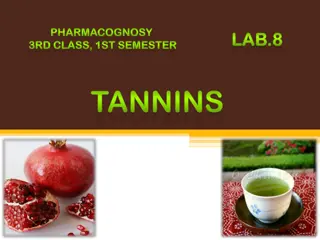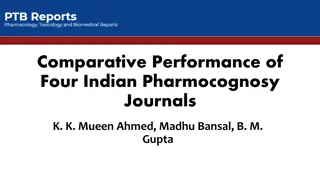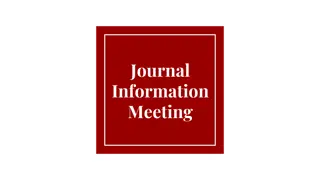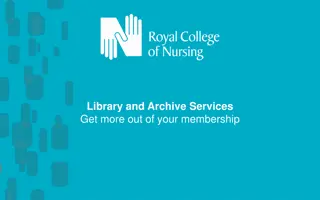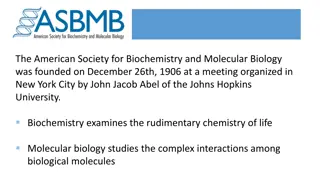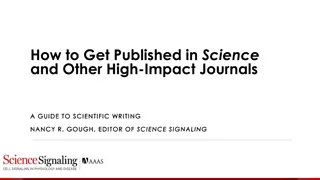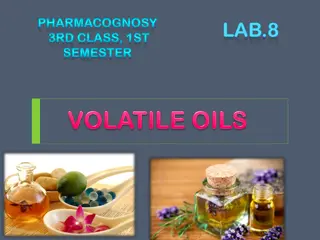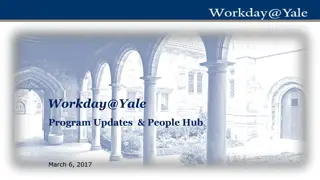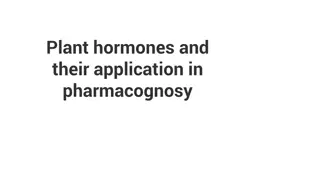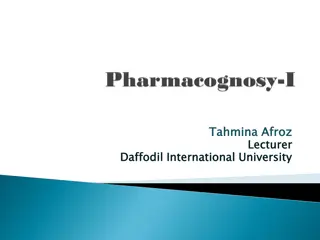Identification of Cardioactive Glycosides in Pharmacognosy Lab Experiments
In this Pharmacognosy lab session, students learn about the identification of cardioactive glycosides through chemical tests like Baljets Test and Keller-Killians Test. These tests involve specific procedures using reagents like picric acid, sodium hydroxide, glacial acetic acid, ferric chloride, an
0 views • 11 slides
Understanding Saponin Glycosides in Pharmacognosy: Properties and Applications
Saponin glycosides, found in various plants, are compounds with diverse benefits ranging from cholesterol regulation to potential anticancer properties. They form colloidal solutions in water and are used in soap manufacturing due to their unique properties. Additionally, saponins have bitter taste,
7 views • 18 slides
Why Choose Leather Bound Journals for Writing
Leather bound journals offer unparalleled elegance and durability, making them the perfect choice for writing enthusiasts. Crafted from premium materials, they exude sophistication while providing a luxurious writing experience. With timeless charm and superior quality, leather journals elevate your
1 views • 7 slides
Navigating Dissertation Topics for Academic Career Paths
To align your dissertation with your career path, consider the teaching, middle, and research tracks. Teaching tracks focus on publishable topics related to desired fields. Middle tracks require publications in reputable journals, showcasing both research and teaching skills. Research tracks emphasi
0 views • 9 slides
Sources of Crude Drugs: Plant, Animal, Marine, and Tissue Culture in Pharmacognosy
Crude drugs are natural substances obtained from plants, animals, and minerals. They are used without much processing and have therapeutic properties. Different plant parts like leaves, flowers, fruits, seeds, roots, bark, and stems yield various important drugs. Animals and minerals also serve as s
1 views • 19 slides
Understanding Glycosides: Secondary Metabolites in Pharmacognosy
Glycosides are naturally occurring compounds with sugar and non-sugar components. They are characterized by glycosidic bonds and can be chemically separated. These compounds exhibit various physical and chemical properties, including solubility, taste, and optical activity. Classification based on g
1 views • 11 slides
Comparison of Alexandrian Senna and Indian Senna: Pharmacognosy and Phytochemistry Insights
Explore the pharmacognosy and phytochemistry of Alexandrian Senna and Indian Senna, detailing their collection, preparation, macroscopic and microscopic characteristics, chemical constituents, and potential adulterants. Learn about the therapeutic applications and commercial significance of these gl
0 views • 30 slides
Exploring Fibers: Cotton, Jute, and Hemp - Pharmacognosy Insights
Discover the world of natural fibers such as cotton, jute, and hemp in pharmacognosy. Learn about their biological sources, chemical constituents, uses, and classification based on origin. Delve into the properties and applications of these fibers, alongside insights on hallucinogens and their effec
0 views • 16 slides
Accessing E-Journals at KeMU Library: A Step-by-Step Guide
Explore a comprehensive tutorial on accessing E-journals at Kenya Methodist University (KeMU) Library. Follow simple steps to navigate the library website, log in to the e-resources portal, and access valuable academic materials easily. Utilize this guide to enhance your research and academic pursui
0 views • 15 slides
Pharmacognosy and Phytochemistry II: Atropa Belladonna Overview
Atropa belladonna, commonly known as belladonna, is a plant rich in tropane alkaloids like atropine and scopolamine. This plant, belonging to the Solanaceae family, has various medicinal uses. Its distinct morphology and geographical sources make it a significant botanical specimen in pharmacognosy
0 views • 13 slides
Understanding Tannins: Properties, Uses, and Structures in Pharmacognosy
Tannins, complex phenolic glycosides found in plants, have various properties such as water solubility and ability to precipitate proteins. They are important for their astringency and therapeutic uses in tanning, treating burns, and as antioxidants. The interaction of tannins with macromolecules is
3 views • 18 slides
Role of Pharmacognosy in Various Systems of Medicine
Pharmacognosy plays a crucial role in modern medicine like allopathy and traditional systems such as Ayurveda, Unani, Siddha, Homeopathy, and Chinese medicine. It involves the study of natural products obtained from plants, animals, minerals, etc., and their use in treating various health conditions
0 views • 11 slides
Insights into Open Access Journals from 2008 to 2019
Dive into the world of Open Access Journals from 2008 to 2019 through an exploration of publication trends, impact factors, acceptance rates, and key contributors. Discover the significance of OA in various fields and its role in advancing research accessibility.
0 views • 9 slides
Bluebook Guide for Law Reviews and Journals at Penn State Law
The presentation provides a detailed overview of the Bluebook rules and formatting conventions for citing legal sources in law reviews and journals, specifically tailored for Penn State Law students. It covers proper citation forms, typeface conventions, and examples for main text and footnote citat
1 views • 105 slides
History, Development, and Scope of Pharmacognosy
Pharmacognosy is the study of medicinal uses of crude drugs obtained from plants and natural resources. It involves researching physical, chemical, and biological properties of drugs from natural sources. The history of pharmacognosy dates back to prehistoric times, where the use of medicinal plants
0 views • 17 slides
Tips and Tricks for Doing a Literature Review Successfully
Explore valuable insights and strategies shared by Khaled Hussainey, a Professor of Accounting & Financial Management, University of Portsmouth, UK. Gain knowledge on structuring literature reviews, identifying research gaps, developing hypotheses, and conducting systematic literature reviews. Disco
0 views • 66 slides
Understanding Cardiac Glycosides in Pharmacognosy and Phytochemistry
Explore the role of Steroids, Cardiac Glycosides, and Triterpenoids in pharmacognosy and phytochemistry, focusing on their general introduction, composition, chemistry, biosources, therapeutic uses, and commercial applications. Learn about the structure and attachment of sugar parts in Cardiac Glyco
9 views • 9 slides
Isolation of Cardioactive Glycosides in Pharmacognosy Lab: Procedure and Results
In this pharmacognosy lab experiment, the aim is to isolate cardioactive glycosides from plant material using various equipment and reagents. The procedure involves maceration, extraction, and separation steps to isolate Fraction A containing the whole glycoside. The results indicate successful isol
0 views • 8 slides
Identification of Cardioactive Glycosides in Pharmacognosy Lab Experiments
The lab experiments focus on identifying cardioactive glycosides using chemical tests like Baljets Test and Keller-Killians Test, along with the identification of sterol glycosides through Raymmonds and Kedds reactions. These tests involve specific procedures with different reagents to observe color
0 views • 11 slides
National NSSLHA Membership Benefits and Resources
Explore the exclusive benefits of being a member of National NSSLHA, including academic resources, money-saving discounts, access to scholarly journals, scholarships, conversion discounts, and more. Gain clinical resources like academic journals, practice portals, and join special interest groups fo
0 views • 10 slides
Understanding Academic Journals: Ownership, Operations, and Processes
Explore the inner workings of academic journals, including ownership by the academic community, key operational structures, and the review process timeline. Gain insights into reputable vs. predatory publishers, implications of ownership, and the roles of editors, reviewers, and policy boards.
0 views • 17 slides
Essential Insights on Volatile Oils and Their Properties in Pharmacognosy
Explore the fascinating world of volatile oils in pharmacognosy with Dr. Nisha Sharma, an Associate Professor at C.S.J.M. University. Learn about the physical and chemical properties of volatile oils, their classification based on functional groups, and examples of different types of volatile oils u
0 views • 12 slides
Understanding Different Types of Literature: Journals and Conference Papers
Explore the distinctions between trade and scholarly journals, the value of scholarly articles for higher-order thinking, and the insights provided by conference papers for practicing planners. Learn how to search for journal articles and conference papers effectively in preparation for research in
1 views • 7 slides
Common Mistakes in Literary Double-Entry Journals
Diction analysis in double-entry journals often involves discussing the author's word choice and its impact on the overall meaning. Examples from various literary works, such as Bradbury's "Fahrenheit 451," demonstrate how specific words contribute to characterization and thematic development. Under
1 views • 25 slides
Introduction to Practical Pharmacognosy: Study of Medicines from Natural Sources
Pharmacognosy is the study of medicines derived from natural sources, exploring drugs from plants through the lenses of botany, chemistry, and pharmacology. This includes the classification of vegetable drugs based on taxonomic, chemical, and morphological characteristics. Understanding key points f
0 views • 19 slides
UC San Francisco School of Medicine Finance Managers Meeting FY End 2019 Summary
The UC San Francisco School of Medicine held a Finance Managers Meeting for Fiscal Year End 2019 on June 26, 2019. The meeting covered key dates, payroll cycles, fiscal close guidelines, accruals, purchasing deadlines, and more. Important deadlines for financial journals, payroll expenses, accountin
0 views • 15 slides
Campus Journals and General Ledger Overview
Campus Journals in September 2014 cover various topics such as Icebreaker activities, Ground Rules, Safety procedures, Disclaimers, Class Format, Agenda for the session, Campus Journal types, and Transaction Types. The content includes descriptions of different journal types and transaction types, a
0 views • 43 slides
Archiving and Presenting Journals with Rosetta at IGeLU Conference
Explore the journey of archiving journals with Rosetta as presented at the IGeLU Conference. From implementing DigiTool to reshaping concepts for Rosetta, the process of managing journals and collections is detailed with insights and challenges faced along the way.
0 views • 16 slides
Understanding Tannins in Pharmacognosy: Properties, Structure, and Uses
Tannins are phenolic compounds found in plants, known for their complex nature and diverse properties. They are soluble in various solvents, play a role in tanning leather, and have medicinal uses such as treating burns and acting as antioxidants. The interaction between tannins and macromolecules i
0 views • 18 slides
Comparative Performance of Indian Pharmacognosy Journals
Analysis of articles from four Indian pharmacognosy journals during 2010-2013 and their citations until 2015 revealed that Pharmacognosy Reviews outperformed others in terms of impact. Suggestions were made for journals to enhance quality through improved peer review standards and attracting eminent
0 views • 8 slides
Exciting Opportunities in Legal Journals
Explore the Alabama Civil Rights and Civil Liberties Law Review and the Journal of the Legal Profession for valuable opportunities in legal writing and publishing. From addressing civil rights issues to exploring dynamic changes in the legal profession, these journals offer credits, publication chan
0 views • 12 slides
Supporting Mentors and Associate Teachers in Weekly Meetings and Target Setting
Mentors play a crucial role in supporting Associate Teachers through weekly meetings and developmental conversations, focusing on setting targets for continued growth. Associate Teachers share Progress Journals and Subject-Specific Development Journals via One Drive, highlighting their course and sc
0 views • 5 slides
Enhance Your Membership Benefits with RCN Libraries
Access a wealth of online resources, expert help, and advice from information professionals at RCN Libraries in London, Cardiff, and Edinburgh. Explore e-books, e-journals, subject guides, and video tutorials to support your work, studies, and CPD. Login with your RCN membership or email to enjoy ea
0 views • 9 slides
The American Society for Biochemistry and Molecular Biology - Advancing Research in Life Sciences
Founded in 1906, the American Society for Biochemistry and Molecular Biology (ASBMB) is a prominent organization that explores the fundamental chemistry of life and intricate interactions among biological molecules. ASBMB publishes prestigious research journals covering various fields such as microb
0 views • 5 slides
Guide to Getting Published in High-Impact Science Journals
Valuable insights on scientific writing, publication opportunities in the AAAS Science Family of Journals, submission process details, review criteria, and acceptance rates, providing a comprehensive guide for aspiring researchers.
0 views • 45 slides
Publishing Requirements and Challenges in Horizon Europe
The publication landscape under Horizon Europe presents challenges regarding compliance with publishing fee eligibility for hybrid journals and embargoes for open access. Hybrid journals feature subscription-based and open access parts, while open access journals require authors to pay open access f
0 views • 6 slides
Understanding Volatile Oils in Pharmacognosy: Properties and Applications
Volatile oils, also known as essential oils, play a crucial role in pharmacognosy due to their complex composition and therapeutic benefits. These oils are immiscible with water but soluble in organic solvents, and their chemical composition includes terpene derivatives and aromatic compounds. They
0 views • 11 slides
Workday@Yale Program Updates & People Hub Summary
This document provides details on the Workday@Yale program updates and People Hub agenda for March 6, 2017. It covers program updates including Spend/Revenue Categories for ISP Journals, COA Converter usage, Web Service Definitions, Testing Reminders, and Deployment Future Forum Topic. Additionally,
0 views • 21 slides
Understanding Plant Hormones and Their Role in Pharmacognosy
Plant hormones, also known as phytohormones, are essential chemical compounds in plants that regulate various developmental processes. They include auxins, gibberellins, cytokinins, ethylene, and abscisic acid, each with specific functions in growth, reproduction, and response to environmental stimu
0 views • 21 slides
Overview of Pharmacognosy and Natural Products
Pharmacognosy is the study of medicinal drugs derived from natural sources, focusing on the properties and origins of crude drugs like plants and animals. The term was coined in 1815, emphasizing knowledge of drugs' physical, chemical, and biological properties. It is associated with various branche
0 views • 18 slides



